
In this instalment of Kernow’s Smaller Villages, Kiera Smitheram returns to her home village of Angarrack to explore its rich and surprisingly industry-shaping history, as well as reflect on how living there shaped her.
Tucked on the eastern outskirts of Hayle on the North Coast of Cornwall, Angarrack is commonly associated with the signpost for the West Cornwall Shopping Park. As you approach the roundabout to turn right into the carpark, or head over to the Rugby Club, the left turn seems to lead only to a sprawling industrial estate. If you decide to venture further down the narrow, twisting road that lies beyond, you would be surprised to discover a village. It is barely even that. It has no shops or facilities of any kind; only a pub, the Methodist chapel with the hall at the back, a post box that still says “GR,” and a telephone box. Every other building in sight is residential. The “corner shop” is Marks and Spencer, just under a mile away from the end of the village (or Lidl if you don’t mind an extra five minute walk). Its sense of community makes up for its lack of facilities tenfold.
My parents moved to the village from Hayle, my ancestral home, in 2000. My mother was expecting and they were looking for somewhere bigger to accommodate another member of the expanding Smitheram clan. Back then, my parents were keen property developers and stumbled across the bungalow that would become my home. In 2007 we moved down the road to the tiny 17th century ex-farmhand cottage where I spent my life until I moved away to Sussex in 2016. I visit every summer for a period, to lounge in the large garden overrun with chickens, rhubarb, and fruit trees. I get for free what many pay thousands for. Comprised of approximately 113 properties1 and just over 250 residents, I tell people at parties with a laugh that I spent my childhood at the “bottom end of nowhere” in a village that in Kernewek (the Cornish language) means “The Rock”.
Growing up at the bottom of The Rock was a mixed experience. On one hand, my sister and I had a lot of freedom to play in the village with the other children and when I got into the last years of school I had the luxury of revising in the sun without urban distractions. However, as I got older, I felt isolated and it became difficult to co-ordinate social activities. There were not many people of my generation who lived there then so I spent a lot of time away from Angarrack at friend’s houses or working. Everyone knows everyone there and though it was very handy on a Friday night at the Angarrack Inn (I don’t think I bought a drink once during my last summer at home), it made building new relationships harder when I moved away as I had lived a life of always knowing people. Like many of the 18-30 year-olds leaving Cornwall from its most remote corners, entering the veritable metropolis of the land beyond the Tamar can be quite a shock. A phenomenally huge 90% of the young people each year leave Cornwall for higher education2, so the lack of late teens and young adults was not a singularity in my village.
For some, the lack of this demographic is a positive. Known as a haven for retirees, young families, and tourists seeking a rustic escape, Angarrack is a far cry from its busy industrial past.
Geographically, Angarrack is fairly simple; the central point of the village (through spiritually it’s the pub) is a crossroads. The first connects the two hills out of the village – Hatch’s Hill (named after the family that lived on it) which leads back into Hayle via Loggan’s Moor, and Steamer’s Hill (thus named after the steam engine that pulled the mined copper out of the village) that leads you parallel to the old A30 road to Camborne. The second road links the residential street of Riverside, which lies along the lowest point of the valley, to the rest of the world via Marsh Lane. Along each road are a few offshoot closes and cul-de-sacs but these are more recent additions to the village. The old water pump just off the crossroads is used as a meeting point for the village youngsters before heading off on the day’s exploits.
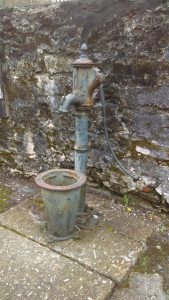 The water pump at the crossroads (Image provided by David Smitheram)
The water pump at the crossroads (Image provided by David Smitheram)
Few cars pass through the place aside from the “rat race” (as my mother calls it) dodging the traffic from the Sunday car-boot sale at the rugby club. It is quite usual to hear the whir of bicycles and scooters careening around on weekend mornings. My garden even had a gate in the hedge leading into my neighbour’s garden so that we kids could just dart through during pretend battles and competitive-level “Hide and Seek”. The village is surrounded on all sides by woodland, farmland and marsh so there are plenty of places to explore. Mine was, to a degree, the perfect rural childhood; we made our own play and snacked on whatever we could find naturally such as blackberries. It was like being in a time warp which could be seen as either good or a bad depending on one’s view. I feel that it gave me an appreciation of the natural world and served as fertile soil for the creativity that has led me to the career that I now have.
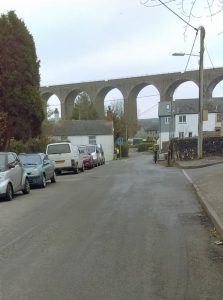 The Crossroads looking towards Riverside and the viaduct (Image provided by David Smitheram)
The Crossroads looking towards Riverside and the viaduct (Image provided by David Smitheram)
The first record of the village is noted in the Domesday Book in 1343 – the medieval census started by William the Conqueror in 1066. This historic tome lists a bridge and a corn mill. Angarrack then seemed to disappear until 1659 when a stamping mill was established and a very long seam of copper unearthed. Two more corn mills appeared around 1700, one of them being Trungle Mill, now a bespoke holiday let and private residence. In 1704, tin was smelted in the village and by 1708 20% of Cornish tin was smelted here. There is not a lot of remaining evidence of these days of industrialisation but if you do a little digging you may find it:
- At the top of the village is the old Manor which is now a private residence.
- A statue has been installed near the crossroads based on the old granite moulds used in smelting.
- A few of the original labourer cottages still stand around the village, such as the one I grew up in.
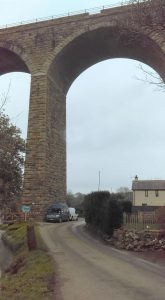 The Viaduct from the East end of Riverside (Image provided by David Smitheram)
The Viaduct from the East end of Riverside (Image provided by David Smitheram)
The most notable landmark is the towering viaduct that splits Riverside down the middle. It is still in use today as part of the only train line in and out of Cornwall. The original wooden bridge was built in 1851. Standing an impressive 100ft tall and 266 yards long, it was designed by world renowned industrial architect, Isambard Kingdom Brunel. In 1885 the current granite version replaced it to keep up with the growing demands for commercial and leisure travel to Cornwall; the stone being sourced from St Erth. Angarrack did have a station on its outskirts – at Ventonleage it can still be seen today – which went all the way to where the ISIS Gardens now stand to deliver resources to the centre of Hayle.
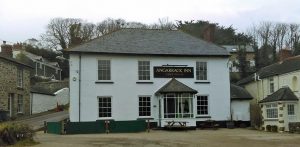 The Angarrack Inn (Image by David Smitheram)
The Angarrack Inn (Image by David Smitheram)
The pub as it stands today has been there since around 1783 and was recorded as the Angarrack Hotel. It was also the home of Lotte Tregorran, a 19th century landlady who rose in notoriety after her son was killed in a bicycle accident. She vowed to seek revenge on the perpetrator – a robin that had flown into a wheel and thrown him off. She apparently killed every robin she encountered until there were almost none left in the village. They did return and can be spotted frequently. If you visit the pub, there is a plaque in her honour and as a strange tribute, lots of ornamental robins!
I worked in the pub for a summer so I saw first-hand the impact such a hub has on a remote community. The Angarrack Inn doesn’t have a television so all news comes by word of mouth. The regulars come and go like clockwork and discuss their days and weeks with anyone who will listen. The openness of the environment is something I have noticed in many small regional pubs. I have visited pubs all over the country that offer a rural atmosphere but none capture it quite like Cornish ones.
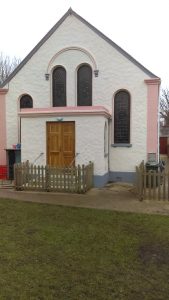 Angarrack Methodist Chapel (Image provided by David Smitheram)
Angarrack Methodist Chapel (Image provided by David Smitheram)
The chapel plays a part in the history of the Wesleyan movement in Cornwall. Charles Wesley, founder of the Methodist Church, preached in the village at Vellan Vrane in 1743. A chapel was erected on the corner of Back Lane in 1834 on a plot donated by Francis Harvey of Harvey’s of Hayle fame. The chapel that stands today is on the site of an old quarry and was erected in 1874. It accommodated both the residents of Angarrack and neighbouring Ventonleague and still receives a congregation today with some people coming from further afield to attend.
There is, of course, one feature of Angarrack that has kept it known to locals and that is the award-winning Christmas Lights. It was started in 1986 by a group of villagers who began by putting up elaborate displays in their gardens and windows. The trend grew and the displays became more elaborate until the New Year’s Flood of 2003 when a decision was made to switch from traditional bulbs to rope lights. This allowed the team to create some of the most ambitious lights displays in Cornwall. Aside from the beautifully intricate designs, some are fully animated and even synced to music! Naturally the villagers are divided in their opinions of them. Some feel that the village isn’t capable of handling the increased traffic, which being a small place is a very true, and the crowds violate their privacy. Others feel that they evoke community spirit with the committee being formed entirely of volunteers, from the designers to fundraisers. Their intricacy and beauty is something that cannot be denied. I remember my sister and me on our bikes following the men who put up the lights, making sure that they went in the right place. I even carried a clipboard with a list of their names and a map of the village. Years later they would tell me that in spite of how annoying it could be from time to time, they did find it helpful when remembering what went where, especially when new displays were being added.
For an unassuming little village on the edge of Hayle, Angarrack has quite an impressive past. It is now a desirable location for its seclusion, its spacious properties and close-knit community. Only a few of the older residents know what shaped it.
Endnotes
The photograph at the top of this article is of the famous viaduct which crosses the village.
1 https://www.streetcheck.co.uk/postcode/tr275wu
2 https://www.independent.co.uk/news/education/education-news/cornwalls-first-university-hopes-to-plug-brain-drain-189389.html

(Photo: by Andrew Worsfold)
Kiera Smitheram is a proudly Cornish soprano, actor, saxophonist, and award-winning writer living in West Sussex.
Born in the ‘bottom end of nowhere’ on the north coast of Cornwall, Kiera spent her free time amusing herself with music, prose, and drama. After dabbling professionally in radio presenting, repertory theatre, and historical interpreting, she found her calling in opera at the age of seventeen in New Cornwall Opera’s “Carmen” at the Minack Theatre. Since then, her appetite for music and theatre has been insatiable.
Kiera is currently studying for a BMus(Hons) in Vocal Performance at the University of Chichester Conservatoire, studying Voice with Yvonne Patrick and Stuart Hutchinson, and Saxophone with Spencer Bundy. She performs regularly in many of the conservatoire’s top ensembles as a singer and a saxophonist. Her academic prowess is also being honed as an apprentice lecturer in Opera and Operetta Studies.
Outside of her studies, Kiera has performed with numerous companies in the Cornwall and Sussex areas. She works extensively with Havant Light Opera, New Sussex Opera, Portsmouth Festival Choir, and West Sussex Opera, as well as freelancing as a soloist for numerous choral societies. She has performed in works by Verdi, Bizet, Handel, Sullivan, Offenbach, and Mendelssohn amongst others.
As a writer, Kiera has been highly praised for her work with the Institute of Cornish Studies, contributing regularly for their online journal dedicated to Cornish history and culture. She won the 2019 Cornish Story Short Fiction Prize for her tragi-comedy tale, “Whatever is Left”.

Good copy Kiera. Tom Kennedy
Although were from different generations,we both had the privilege of growing up in our lovely village of Angarrack.When I was a young lad we still had a village shop and were sent to sunday school each sunday morning ( I think this was only so that mother could cook the sunday roast in peace).Keep up your good work.
Well done ! Just one error …the Angarrack Lights were started by Joan Cook
who persuaded people to join in the fun. She lived opposite the Angarrack Inn.
My great grandfather was Thomas Miles. He left us a short story beginning with
when he left from Angarrack for the United States on April 27,1882.
He met his brother named Manny Miles and a cousin named Henry Miles in
Pennsylvania where he and most of his family lived thereafter.
Researching it appears that my great great grandfather was William Miles
and great great grandmother was Wilmot Cernew and Thomas Miles was
born 18 January 1862.
Are there any Miles or Cernews still living in the Angarrack area or
institutional memories that could be availed to us?
My wife, Laura and I are planning a tour of the British Isles this summer and
will be visiting Cornwall. We plan to be there the second week of July.
We look forward to visiting your beautiful town.
Ted and Laura Miles